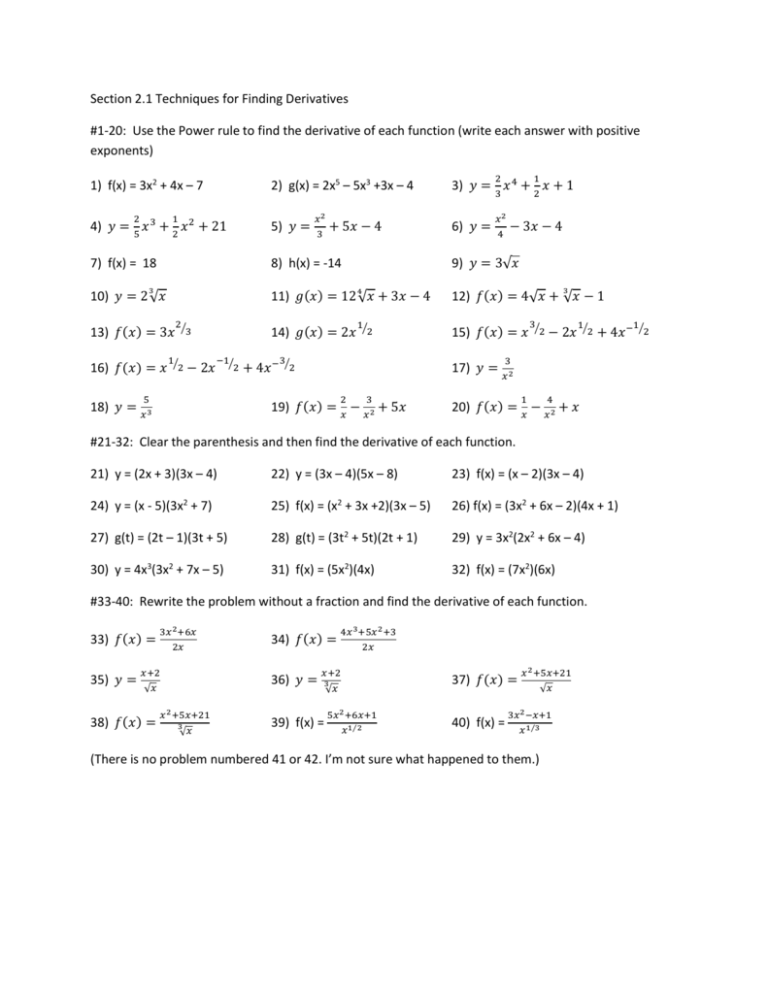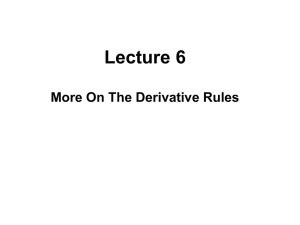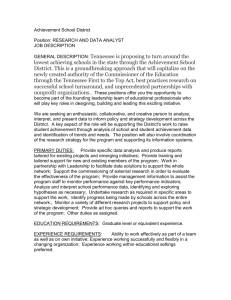chapter 2 problems
advertisement

Section 2.1 Techniques for Finding Derivatives #1-20: Use the Power rule to find the derivative of each function (write each answer with positive exponents) 1) f(x) = 3x2 + 4x – 7 2 2) g(x) = 2x5 – 5x3 +3x – 4 1 𝑥2 3 2 1 𝑥2 4 − 3𝑥 − 4 3) 𝑦 = 3 𝑥 4 + 2 𝑥 + 1 4) 𝑦 = 5 𝑥 3 + 2 𝑥 2 + 21 5) 𝑦 = 7) f(x) = 18 8) h(x) = -14 9) 𝑦 = 3√𝑥 11) 𝑔(𝑥) = 12 4√𝑥 + 3𝑥 − 4 12) 𝑓(𝑥) = 4√𝑥 + √𝑥 − 1 3 10) 𝑦 = 2 √𝑥 13) 𝑓(𝑥) = 3𝑥 16) 𝑓(𝑥) = 𝑥 18) 𝑦 = 2⁄ 3 1⁄ 2 − 2𝑥 + 5𝑥 − 4 14) 𝑔(𝑥) = 2𝑥 −1⁄ 2 5 𝑥3 + 4𝑥 − 1⁄ 2 6) 𝑦 = 3 15) 𝑓(𝑥) = 𝑥 3⁄ 2 17) 𝑦 = 2 𝑥 19) 𝑓(𝑥) = − 3 𝑥2 + 5𝑥 3⁄ 2 − 2𝑥 1⁄ 2 + 4𝑥 − 3 𝑥2 1 𝑥 20) 𝑓(𝑥) = − 4 𝑥2 +𝑥 #21-32: Clear the parenthesis and then find the derivative of each function. 21) y = (2x + 3)(3x – 4) 22) y = (3x – 4)(5x – 8) 23) f(x) = (x – 2)(3x – 4) 24) y = (x - 5)(3x2 + 7) 25) f(x) = (x2 + 3x +2)(3x – 5) 26) f(x) = (3x2 + 6x – 2)(4x + 1) 27) g(t) = (2t – 1)(3t + 5) 28) g(t) = (3t2 + 5t)(2t + 1) 29) y = 3x2(2x2 + 6x – 4) 30) y = 4x3(3x2 + 7x – 5) 31) f(x) = (5x2)(4x) 32) f(x) = (7x2)(6x) #33-40: Rewrite the problem without a fraction and find the derivative of each function. 33) 𝑓(𝑥) = 35) 𝑦 = 3𝑥 2 +6𝑥 2𝑥 𝑥+2 √𝑥 38) 𝑓(𝑥) = 34) 𝑓(𝑥) = 36) 𝑦 = 𝑥 2 +5𝑥+21 3 √𝑥 4𝑥 3 +5𝑥 2 +3 2𝑥 𝑥+2 3 39) f(x) = √𝑥 5𝑥 2 +6𝑥+1 𝑥 1⁄2 37) 𝑓(𝑥) = 40) f(x) = 𝑥 2 +5𝑥+21 √𝑥 3𝑥 2 −𝑥+1 𝑥 1⁄3 (There is no problem numbered 41 or 42. I’m not sure what happened to them.) 1⁄ 2 Section 2.1 Techniques for Finding Derivatives #43-52: a) Find the slope of the tangent line to the graph of the function for the given value of x. b) Find the equation of the tangent line to the graph of the function for the given value of x. 43) f(x) = 3x2 + 6x – 2; x = 2 44) f(x) = 2x2 - 6x – 2; x = 3 3 46) 𝑔(𝑥) = 12 4√𝑥 + 3𝑥 − 4; 𝑥 = 16 45) 𝑓(𝑥) = 4√𝑥 + √𝑥 − 1; 𝑥 = 64 1 4 2 47) 𝑓(𝑥) = 𝑥 − 𝑥 2 + 𝑥; 𝑥 = −2 49) 𝑦 = 5 ; 𝑥3 50) 𝑦 = x=1 51) 𝑓(𝑥) = 𝑥 3⁄ 2 − 2𝑥 1⁄ 2 + 4𝑥 − 1⁄ 2; 3 48) 𝑓(𝑥) = 𝑥 − 𝑥 2 + 5𝑥; 𝑥 = −3 3 ; 𝑥2 x=3 52) 𝑓(𝑥) = 𝑥 x=4 1⁄ 2 − 2𝑥 −1⁄ 2 + 4𝑥 − 3⁄ 2; x=9 #53-62: a) Find all values of x where the tangent line is horizontal b) Find the equation of the tangent line to the graph of the function for the values of x found in part a. 53) f(x) = 3x2 + 6x + 2 54) f(x) = 2x2 – 5x + 7 56) f(x) = (2x-5)(x+1) 57) f(x) = 3 𝑥 3 + 2 𝑥 2 + 6𝑥 58)𝑓(𝑥) = 3 𝑥 3 + 3𝑥 2 − 7𝑥 59) y = x3 – 5x2 +6x + 3 60) y = x3 – 4x2 -7x + 8 61) y = x3 + 3x2 62) y = 2x3 – 4x2 1 5 55) f(x) = (x-3)(3x-4) 1 Section 2.2 Derivatives of Products and Quotients #1-14: Use the product rule to find the derivatives of the following. 1) y = (2x + 3)(3x – 4) 2) y = (3x – 4)(5x – 8) 3) f(x) = (x – 2)(3x – 4) 4) y = (x - 5)(3x2 + 7) 5) f(x) = (x2 + 3x +2)(3x – 5) 6) f(x) = (3x2 + 6x – 2)(4x + 1) 7) g(t) = (2t – 1)(3t + 5) 8) g(t) = (3t2 + 5t)(2t + 1) 9) y = 3x2(2x2 + 6x – 4) 10) y = 4x3(3x2 + 7x – 5) 11) f(x) = (5x2)(4x) 12) f(x) = (7x2)(6x) 13) 𝑦 = (3𝑥 −4 )(5𝑥 2 + 7) 14) 𝑦 = (2𝑥 −5 )(5𝑥 − 8) #15-30: Use the quotient rule to find the derivative of the following. 4𝑥−3 15) 𝑓(𝑥) = 5𝑥+1 7𝑥−4 16) 𝑔(𝑥) = 3𝑥+11 17) 𝑦 = 9𝑥 𝑥−5 18) 𝑦 = 12𝑥 3𝑥−6 19) 𝑦 = 6𝑡 2 +5𝑡 5−2𝑡 20) 𝑦 = 3𝑡 2 −𝑡 5+4𝑡 21) 𝑔(𝑥) = 𝑥 2 +3 2𝑥−4 22) 𝑔(𝑥) = 5𝑥 2 +3𝑥 𝑥−2 23) 𝑘(𝑡) = 𝑡 2 +3𝑡−4 2𝑡−1 24) 𝑘(𝑡) = 3𝑡 2 +𝑡−2 5𝑡+9 𝑦 √ 25) 𝑓(𝑦) = 2𝑦−1 27) 𝑦 = 29) 𝑦 = 31) 𝑦 = 3𝑥+5 √𝑥 (2𝑥−3)(4𝑥+1) 𝑥+2 (2𝑥 2 −3)(𝑥−1) 7𝑥+4 3 𝑦 √ 26) 𝑓(𝑦) = 2𝑦+5 28) 𝑦 = 30) 𝑦 = 32) 𝑦 = 𝑥 2 +5 3 √𝑥 (𝑥−5)(4𝑥+2) 3𝑥+1 (𝑥 2 −5)(4𝑥−3) 𝑥+8 Section 2.2 Derivatives of Products and Quotients #33-42: a) Find the slope of the tangent line to the graph of the function for the given value of x (or t). b) Find the equation of the tangent line to the graph of the function for the given value of x (or t). (HINT YOU MAY HAVE ALREADY COMPUTED THE DERIVATIVE FOR EACH OF THESE FUNCITONS, SEE PREVIOUS PROBLEMS IN THIS SECTION.) 33) y = (2x + 3)(3x – 4); x=2 34) y = (3x – 4)(5x – 8); x = 3 35) g(t) = (2t – 1)(3t + 5); t = 4 36) g(t) = (3t2 + 5t)(2t + 1); t = -2 37) y = 3x2(2x2 + 6x – 4); x = 1 38) y = 4x3(3x2 + 7x – 5) ; x = 1 39) 𝑓(𝑥) = 41) 𝑦 = 4𝑥−3 ; 5𝑥+1 9𝑥 ; 𝑥−5 x=1 x = -3 40) 𝑔(𝑥) = 42) 𝑦 = 7𝑥−4 ; 3𝑥+11 12𝑥 ; 3𝑥−6 x=2 x = -4 Section 2.3 The Chain Rule #1-10: Find f[g(x)], and don’t simplify your answer!!! 1) f(x) = x3; g(x) = x2 + 2x + 1 2) f(x) = x4; g(x) = 4x2 + x - 5 3) f(x) = √𝑥; 4) f(x) = √𝑥 ; g(x) = 3x – 1 3 g(x) = 2x – 7 5) 𝑓(𝑥) = 𝑥 2⁄3 ; g(x) = x2 +4 6) 𝑓(𝑥) = 𝑥 4⁄5 ; g(x) = x2 + 4 7) f(x) = ex; g(x) = x2 + 2x + 1 8) f(x) = ex; g(x) = 4x2 + x - 5 9) f(x) = ln(x); g(x) = 3x + 5 10) f(x) = ln(x); g(x) = 2x-7 #11-20: Create two functions f(x) and g(x) such that h(x) = f[g(x)] 11) h(x) = (x-3)2 12) h(x) = (2x-5)3 1⁄ 3 1⁄ 2 13) h(x) = (𝑥 − 4) 14) h(x) = (𝑥 − 2) 15) ℎ(𝑥) = √𝑥 + 5 16) ℎ(𝑥) = √7𝑥 + 1 17) h(x) = (x-3)2 + 4(x-3) + 1 18) h(x) = 4(x-1)2 + 6(x-1) + 4 19) h(x) = 2(x4 + x + 1)3 + 3(x4 + x + 1)2 – 3 20) h(x) = 11(x3 + 3x)3 + 3(x3 + 3x)2 – 2 3 #21-32: Use the Chain rule to find the derivative of each function. If h(x) = f[g(x)] then h’(x) = g’(x)*f’[g(x)] 21) h(x) = (2x-4)3 22) h(x) = (5x – 3)2 23) h(x) = 5(7x + 1)4 24) h(x) = 3(8x + 7)5 25) h(x) = 3(2x – 1)-4 26) h(x) = 2(5x – 6)-3 27) ℎ(𝑥) = (𝑥 2 + 6𝑥 + 1)3 28) ℎ(𝑥) = (3𝑥 2 − 5𝑥 + 2)3 29) ℎ(𝑥) = √3𝑥 − 5 30) ℎ(𝑥) = √𝑥 2 + 3 3 31) ℎ(𝑥) = 4√5𝑥 + 1 3 32) ℎ(𝑥) = 7 √4𝑥 + 1 Section 2.3 The Chain Rule #33-46: Find the derivative of each function. 33) 𝑦 = 5𝑥(2𝑥 − 4)3 34) 𝑦 = 5𝑥 2 (7𝑥 + 1)3 35) 𝑔(𝑡) = (𝑡 2 + 6𝑡 − 1)(2𝑡 + 5)2 36) 𝑔(𝑡) = (3𝑡 2 + 5𝑡 − 1)(4𝑡 − 1)2 37) h(y) = (3y + 1)2(6y – 3) 38) f(y) = (2y – 3)(4y + 1)2 39) 𝑦 = 3𝑥 2 √2𝑥 − 5 40) 𝑦 = 4𝑥 √7𝑥 + 1 41) 𝑦 = 2 (3𝑥−4)4 43) 𝑓(𝑥) = 45) 𝑔(𝑥) = (3𝑥−1)2 2𝑥−5 𝑥2 √2𝑥−3 3 42) 𝑦 = 5 (2𝑥−9)3 44) 𝑓(𝑥) = 46) 𝑔(𝑥) = (4𝑥+5)2 2𝑥+1 𝑥3 √5𝑥−7 #47-52: a) Find all values of x where the tangent line is horizontal b) Find the equation of the tangent line to the graph of the function for the values of x found in part a. 47) f(x) = (2x-3)2 48) f(x) = (3x – 4)2 49) y =4x (x – 1)2 50) y =3x (x – 2)2 51) y = 5(x + 3)4 52) y = 7(5x – 6)2 Section 2.4 Derivatives of Exponential Functions and Logarithms #1-32: Find the derivative of each exponential function 1) 𝑦 = 𝑒 3𝑥 2) 𝑦 = 𝑒 7𝑥 3) 𝑓(𝑥) = 𝑒 4𝑥+5 4) 𝑔(𝑥) = 𝑒 9𝑥−1 5) 𝑔(𝑡) = 𝑒 𝑡 2 +3𝑡 6) 𝑓(𝑡) = 𝑒 7𝑡 2 −3𝑡+1 7) 𝑓(𝑥) = 2𝑒 4𝑥 8) 𝑔(𝑥) = 8𝑒 2𝑥+5 9) 𝑦 = 𝑥 2 𝑒 𝑥 10) 𝑦 = 3𝑥 4 𝑒 𝑥 11) 𝑘(𝑦) = (𝑦 + 2)𝑒 3𝑦 12) 𝑓(𝑦) = (2𝑦 − 3)𝑒 5𝑦 13) 𝑦 = (3𝑥 − 4)2 𝑒 5𝑥 14) 𝑦 = (7𝑥 + 1)3 𝑒 6𝑥 15) 𝑦 = (𝑥 2 + 3𝑥 + 1)2 𝑒 5𝑥 16) 𝑦 = (𝑥 2 − 3𝑥 + 1)3 𝑒 2𝑥 17) 𝑓(𝑥) = 𝑥𝑒 −𝑥 18) 𝑔(𝑥) = 𝑥𝑒 −3𝑥 19) 𝑦 = (𝑒 𝑥 + 2𝑥)−2 20) 𝑦 = (𝑒 4𝑥 + 𝑥 2 )−1 21) 𝑔(𝑡) = 23) 𝑦 = 𝑡2 𝑒𝑡 22) 𝑔(𝑡) = 𝑒 𝑥 +𝑒 −𝑥 𝑥 24) 𝑦 = 𝑡3 𝑒𝑡 𝑒 𝑥 −𝑒 −𝑥 𝑥 25) 𝑓(𝑥) = 3𝑥 26) 𝑓(𝑥) = 7𝑥 27) 𝑓(𝑥) = 35𝑥 28) 𝑓(𝑥) = 72𝑥 29) 𝑦 = 3𝑥 ∗ 2𝑥 30) 𝑦 = 𝑥 2 ∗ 2𝑥 31) 𝑦 = 3𝑥 ∗ 2𝑥 2 +5 32) 𝑦 = 𝑥 2 ∗ 2𝑥 4 −8 Section 2.4 Derivatives of Exponential Functions and Logarithms #33-60: Find the derivative of each logarithmic function 33) 𝑦 = ln(4𝑥) 34) 𝑦 = ln(2𝑥) 35) 𝑦 = log(4𝑥) 36) 𝑦 = log(2𝑥) 37) 𝑦 = ln(𝑥 2 + 4𝑥) 38) 𝑦 = ln(𝑥 2 − 5𝑥) 39) 𝑦 = 𝑙𝑜𝑔3 (𝑥 2 + 4𝑥) 40) 𝑦 = 𝑙𝑜𝑔4 (𝑥 2 − 5𝑥) 41) 𝑓(𝑥) = ln(𝑥 − 3)4 42) 𝑓(𝑥) = ln(𝑥 + 5)3 43) 𝑓(𝑥) = 𝑙𝑜𝑔2 (𝑥 − 3)4 44) 𝑓(𝑥) = 𝑙𝑜𝑔7 (𝑥 + 5)3 45) 𝑔(𝑡) = ln(√𝑡 − 4) 46) 𝑔(𝑡) = ln(√3𝑡 + 1) 47) 𝑦 = 3𝑥𝑙𝑛(5𝑥) 48) 𝑦 = 𝑥 2 ln(9𝑥) 49) 𝑔(𝑦) = (𝑦 − 2)ln(3𝑦) 50) 𝑓(𝑦) = (3𝑦 − 4)ln(7𝑦) 51) 𝑔(𝑦) = (𝑦 − 2)ln(3𝑦 + 5) 52) 𝑓(𝑦) = (3𝑦 − 4)ln(7𝑦 − 6) 53) 𝑓(𝑥) = 55) 𝑦 = 𝑒𝑥 ln(𝑥) 54) 𝑓(𝑥) = 3𝑡+4 ln(𝑡) 56) 𝑦 = 2 57) 𝑓(𝑥) = 𝑒 𝑥 ln(5𝑥 + 1) 59) 𝑦 = 𝑒 3𝑥 2 +5𝑥+1 ln(𝑥) ln(𝑥) 𝑒𝑥 2𝑡−5 ln(𝑡) 58) 𝑘(𝑥) = 𝑒 3𝑥 ln(5 − 4𝑥) 60) 𝑦 = 𝑒 𝑥 2 −3𝑥+1 ln(𝑥) #61-68: a) Find all values of x where the tangent line is horizontal b) Find the equation of the tangent line to the graph of the function for the values of x found in part a. 61) 𝑦 = 𝑒 𝑥 2 62) 𝑦 = 𝑒 5𝑥 2 63) 𝑦 = 𝑥𝑒 𝑥 64) 𝑦 = 𝑥 2 𝑒 𝑥 65) 𝑦 = (𝑥 + 3)𝑒 𝑥 66) 𝑦 = (𝑥 + 2)𝑒 𝑥 67) 𝑦 = 𝑥𝑒 2𝑥 68) 𝑦 = 𝑥𝑒 3𝑥 Section 2.5 Applications of Derivatives 1) The cost function for producing x units of a certain product is: C(x) = 100 + 8x + 0.1x2, 1a) Find the cost of producing 100 units of the product. 1b) Create the marginal cost function C’(x) for this product. 1c) Find the marginal cost when 100 units of the product are produced. 1d) Interpret your answer to question 1c. 2) The cost function for producing x units of a certain product is: C(x) = 0.4x2 +7x + 8, 2a) Find the cost of producing 4 units of the product. 2b) Create the marginal cost function C’(x) for this product. 2c) Find the marginal cost when 4 units of the product are produced. 2d) Interpret your answer to question 2c. 3) From past data analysis a manufacturing company finds that the cost of manufacturing for a certain product can be modeled by: 𝐶(𝑥) = 3000 + 11𝑥 − 7√𝑥 + 0.03𝑥 3⁄2 where x represents the number of units produced and C(x) represents the cost in dollars. a) Create the marginal cost function C’(x) for this product. b) Evaluate and interpret C(100). c) Evaluate and interpret C’(100). 4) From past data analysis a manufacturing company finds that the cost of manufacturing for a certain product can be modeled by: 𝐶(𝑥) = 3000 + 10𝑥 2 − 7√𝑥 + 3𝑥 5⁄2 where x represents the number of units produced and C(x) represents the cost in dollars. a) Create the marginal cost function C’(x) for this product. b) Evaluate and interpret C(36). c) Evaluate and interpret C’(36). 5) Suppose that the cost in dollars to make x smart phone cases is given by: 𝐶(𝑥) = 5 ln(𝑥) + 10 a) Create the marginal cost function C’(x) for this product. b) Evaluate and interpret C(10). (round your answer to 2 decimals) c) Evaluate and interpret C’(10). 6) Suppose that the cost in dollars to make a x pairs of socks is given by: 𝐶(𝑥) = 3 ln(𝑥 2 ) + 2 a) Create the marginal cost function C’(x) for this product. b) Evaluate and interpret C(10). (round your answer to 2 decimals) c) Evaluate and interpret C’(10).Section 2.5 Applications of Derivatives Section 2.5 Applications of Derivatives 7) Bob’s Bobble heads company determines the profit function for producing and selling a certain bobble head can be modeled by: 𝑃(𝑥) = −0.001𝑥 2 + 8𝑥 − 1000 0 ≤ 𝑥 ≤ 7000. Where x represents the number of bobble heads sold and P(x) represents the monthly profit in dollars. a) Determine P’(x) b) Evaluate and interpret P(1000). (round your answer to 2 decimals) c) Evaluate and interpret P’(1000). 8) The Radio Corporation determines the weekly profit (P(x)) from selling x radios can be modeled by: 𝑃(𝑥) = −0.01𝑥 2 + 12𝑥 − 2000 0 ≤ 𝑥 ≤ 1000. a) Determine P’(x) b) Evaluate and interpret P(500). (round your answer to 2 decimals) c) Evaluate and interpret P’(500). 9) A newspaper courier determines that the monthly profit from his current newspaper route can be modeled by: 𝑃(𝑥) = 2𝑥 − √𝑥 0 ≤ 𝑥 ≤ 200; where x represents the number of papers delivered and P(x) represents the monthly profit. a) Determine P’(x) b) Evaluate and interpret P(100). c) Evaluate and interpret P’(100). 10) A telemarketing company has determined that the monthly profit (P(x)) from selling x magazine subscriptions can be modeled by: 𝑃(𝑥) = 5𝑥 + √𝑥 0 ≤ 𝑥 ≤ 100 a) Determine P’(x) b) Evaluate and interpret P(20). (round your answer to 2 decimals) c) Evaluate and interpret P’(20). (round your answer to 2 decimals) 11) The number of dollars spent on advertising for a product influences the number of items of the product that will be purchased by customers. The number of Eddie Van Halen limited edition guitars that will be purchased by customers is a function of the amount spent on advertising and can be modeled by: Where x represents the number of thousands of dollars spent on advertising. 𝑁(𝑥) = 150 − 200 𝑥 a) Determine N’(x) b) Evaluate and interpret N(5). c) Evaluate and interpret N’(5). Section 2.5 Applications of Derivatives 12) The number of dollars spent on advertising for a product influences the number of items of the product that will be purchased by customers. The number of diamond rings that will be purchased by customers is a function of the amount spent on advertising and can be modeled by: Where x represents the number of thousands of dollars spent on advertising. 𝑁(𝑥) = 150 − 200 𝑥 a) Determine N’(x) b) Evaluate and interpret N(5). c) Evaluate and interpret N’(5). 13) A Sun City couple has a small garden and they grow blueberries. They have found the price-demand function is: 𝑝(𝑥) = −0.25𝑥 + 5.50 Where x is the number of quarts of blueberries demanded and p(x) represents the price per quart in dollars. a) Find and interpret p(5) round to 2 decimals. b) Create a revenue function R(x). Hint: R(x) = x*p(x) (revenue = quantity*price) c) Find R’(x) d) Evaluate and interpret R(5). (Round your answer to 2 decimals.) e) Evaluate and interpret R’(5). 14) A Boy Scout troop builds pinewood derby cars. They have found the price-demand function is: 𝑝(𝑥) = −0.50𝑥 + 25 Where x is the number of pinewood derby cars demanded and p(x) represents the price of a car in dollars. a) Find and interpret p(10) round to 2 decimals. b) Create a revenue function R(x) hint R(x) = x*p(x) (revenue = quantity*price) c) Find R’(x) d) Evaluate and interpret R(10). (round your answer to 2 decimals) e) Evaluate and interpret R’(10). Chapter 2 Review #1-4: Use the Power rule to find the derivative of each function (write each answer with positive exponents) 1) g(x) = 2x4 – 4x3 +2x2 – 4x + 1 4) 𝑓(𝑥) = 3 2 2) 𝑓(𝑥) = 𝑥 − 𝑥 2 + 7𝑥 3) 𝑓(𝑥) = 3√𝑥 2𝑥 2 +3𝑥−8 𝑥 5) 𝑓(𝑥) = 3𝑥 2 + 5𝑥; 𝑎𝑡 𝑥 = 2 a) Find the slope of the tangent line to the graph of the function for the given value of x. b) Find the equation of the tangent line to the graph of the function for the given value of x. 6) 𝑓(𝑥) = 6𝑥 2 − 24𝑥 + 8 a) Find all values of x where the tangent line is horizontal b) Find the equation of the tangent line to the graph of the function for the values of x found in part a. #7-8: Use the product rule to find the derivatives of the following functions. 8) 𝑦 = 4𝑡 2 (5𝑡 + 3) 7) 𝑦 = (3𝑥 − 1)(5𝑥 + 6) #9-10: Use the quotient rule to find the derivatives of the following functions. 9) 𝑘(𝑡) = 3𝑡−5 2𝑡+9 10) 𝑓(𝑦) = 2𝑦 3𝑦+4 #11-12: Use the chain rule to find the derivatives of the following functions. 11) 𝑦 = (5𝑥 2 − 3𝑥 + 2)4 12) 𝑓(𝑥) = √2𝑥 2 + 1 #13 – 19: Use the appropriate technique to find the derivatives of the following functions. 13) 𝑔(𝑡) = 5𝑡(3𝑡 + 1)2 14) 𝑦 = 2𝑥(𝑥 + 5)3 15) 𝑔(𝑥) = 𝑒 3𝑥+4 16) 𝑓(𝑦) = (2𝑦 − 5)𝑒 3𝑦 𝑡3 17) 𝑔(𝑡) = 𝑒 𝑡 19) 𝑦 = 4𝑥𝑙𝑛(3𝑥) 18) 𝑔(𝑡) = ln(5𝑡 4 ) Chapter 2 Review 20) 𝑓(𝑥) = 𝑥𝑒 2𝑥 a) Find all values of x where the tangent line is horizontal b) Find the equation of the tangent line to the graph of the function for the values of x found in part a. 21) Suppose that the cost in dollars to make x super-sized candy bars is given by: 𝐶(𝑥) = 3 ln(𝑥) + .25 a) Determine C’(x) b) Evaluate and interpret C(5). (round your answer to 2 decimals) c) Evaluate and interpret C’(5). 22) Bob’s hacky sack company determines the profit function for producing and selling a certain hacky sack can be modeled by: 𝑃(𝑥) = −0.001𝑥 2 + 7𝑥 − 800 0 ≤ 𝑥 ≤ 7000. Where x represents the number of hacky sacks sold and P(x) represents the monthly profit in dollars. a) Determine P’(x) b) Evaluate and interpret P(1000). (round your answer to 2 decimals) c) Evaluate and interpret P’(1000). Chapter 2 Practice Test Part 1 #1 – 13: Use the appropriate technique to find the derivatives of the following functions. 1) f(x) = 3x2 – 5x + 4 −3 4𝑥 2 5𝑥 2 +3 𝑓(𝑥) = 𝑥 2 𝑦2 𝑔(𝑦) = 3𝑦−5 3 (5𝑥 2) 𝑓(x)= 3 3) 𝑓(𝑥) = 2√𝑥 2 4) 5) 𝑓(𝑥) = (𝑥 2 + 6𝑥)(3𝑥 − 1) 5 7) 𝑔(𝑡) = 2(4𝑡 − 3) 6) 8) 𝑦 = 4𝑥 + 3)2 9) 𝑓(𝑥) = 𝑥 2 + 3𝑥; 𝑎𝑡 𝑥 = −2 a) Find the slope of the tangent line to the graph of the function for the given value of x. b) Find the equation of the tangent line to the graph of the function for the given value of x. 10) 𝑓(𝑥) = 𝑥 2 + 8𝑥 − 4 a) Find all values of x where the tangent line is horizontal b) Find the equation of the tangent line to the graph of the function for the values of x found in part a. Chapter 2 Practice Test Part 2 11) 𝑔(𝑥) = 𝑒 𝑥 13) 𝑔(𝑡) = 2 5𝑡 4 𝑒 2𝑡 12) 𝑓(𝑦) = (2𝑦 − 4)𝑒 5𝑦 2 14) 𝑔(𝑡) = ln(3𝑡 5 ) 15) 𝑦 = 𝑥 2 𝑙𝑛(𝑥) 16) 𝑓(𝑥) = 𝑒 𝑥 2 a) Find all values of x where the tangent line is horizontal b) Find the equation of the tangent line to the graph of the function for the values of x found in part a. 17) Suppose that the cost in dollars to make x super-sized candy bars is given by: 𝐶(𝑥) = 2 ln(𝑥) + .15 a) Determine C’(x) b) Evaluate and interpret C(4). (round your answer to 2 decimals) c) Evaluate and interpret C’(4).








